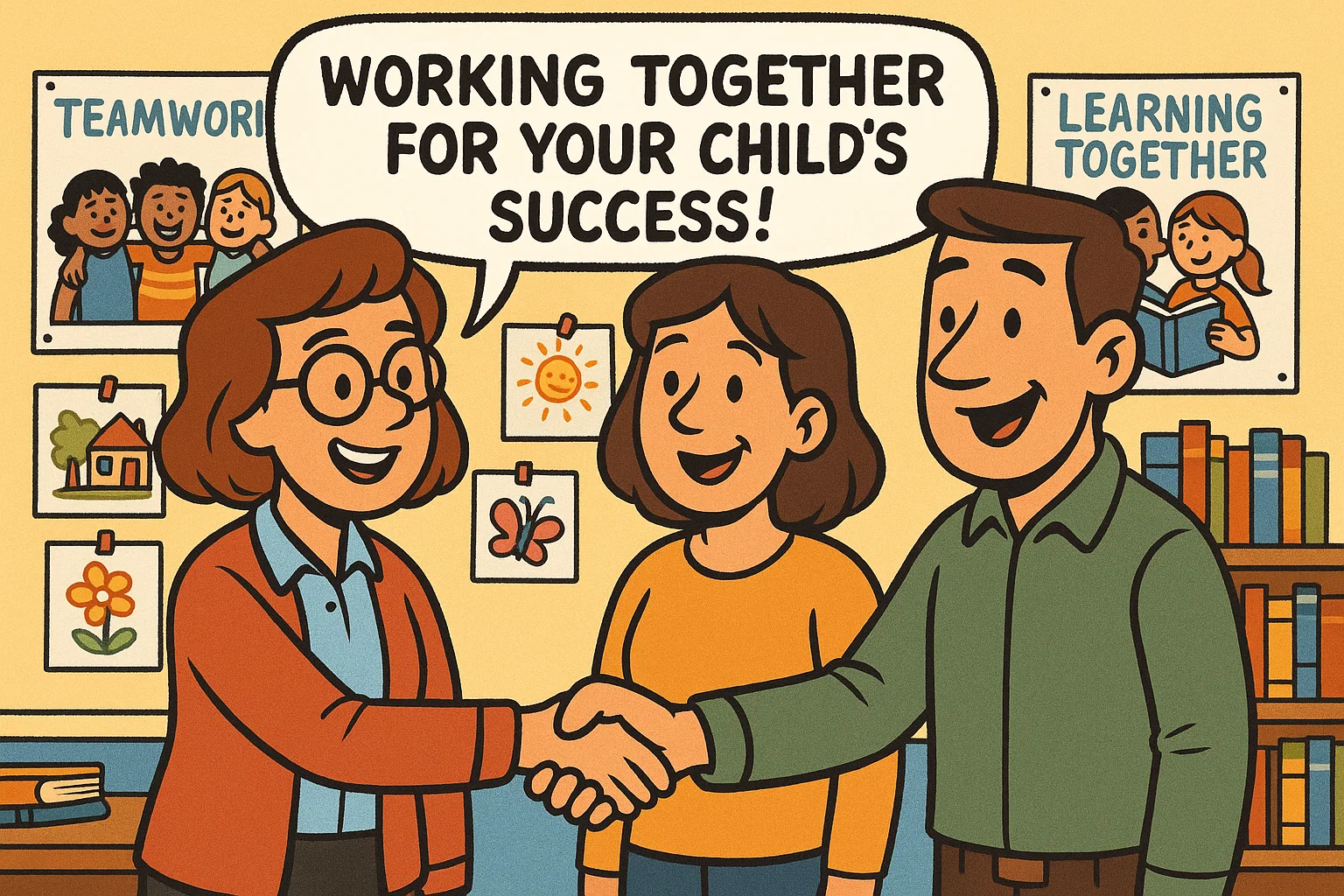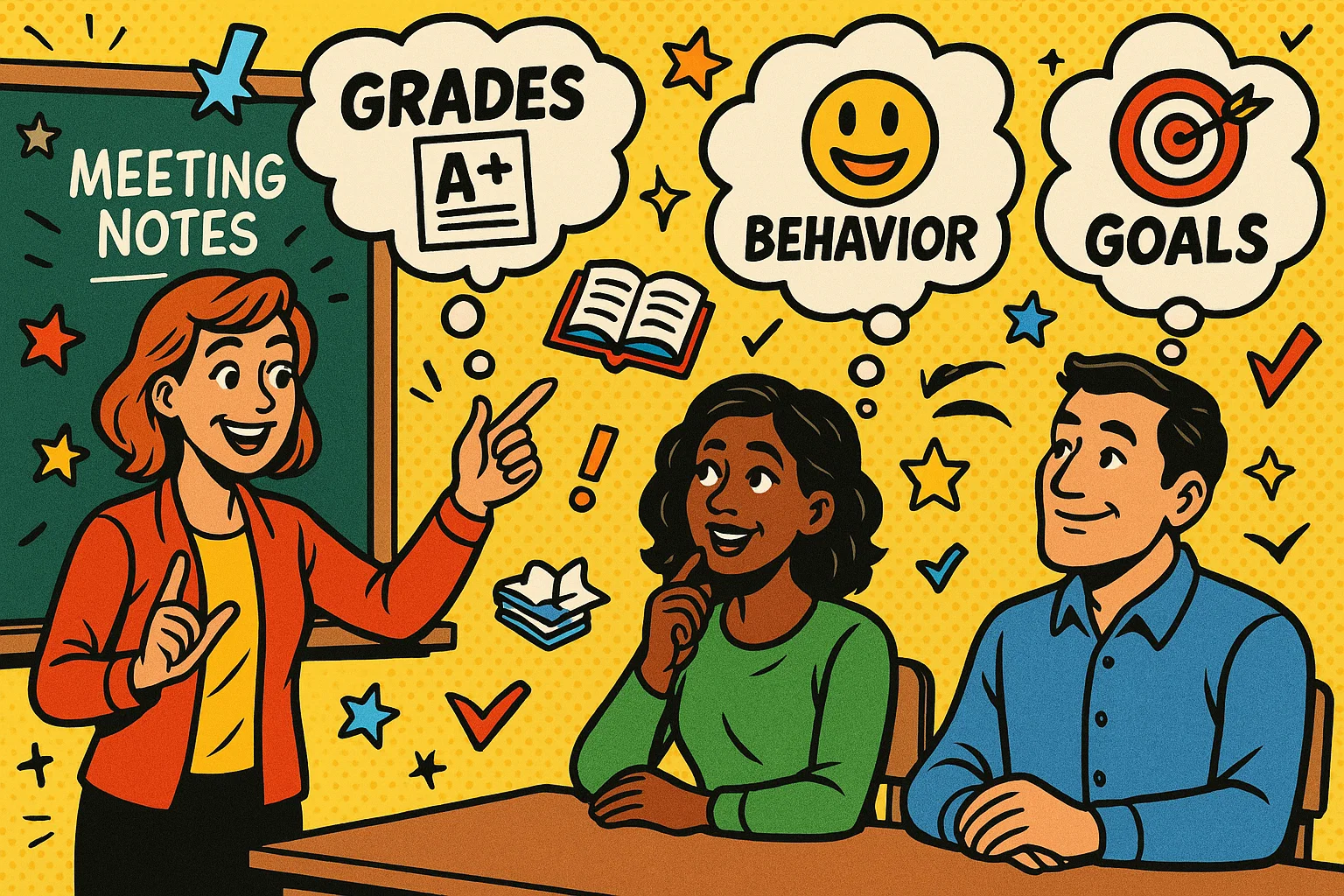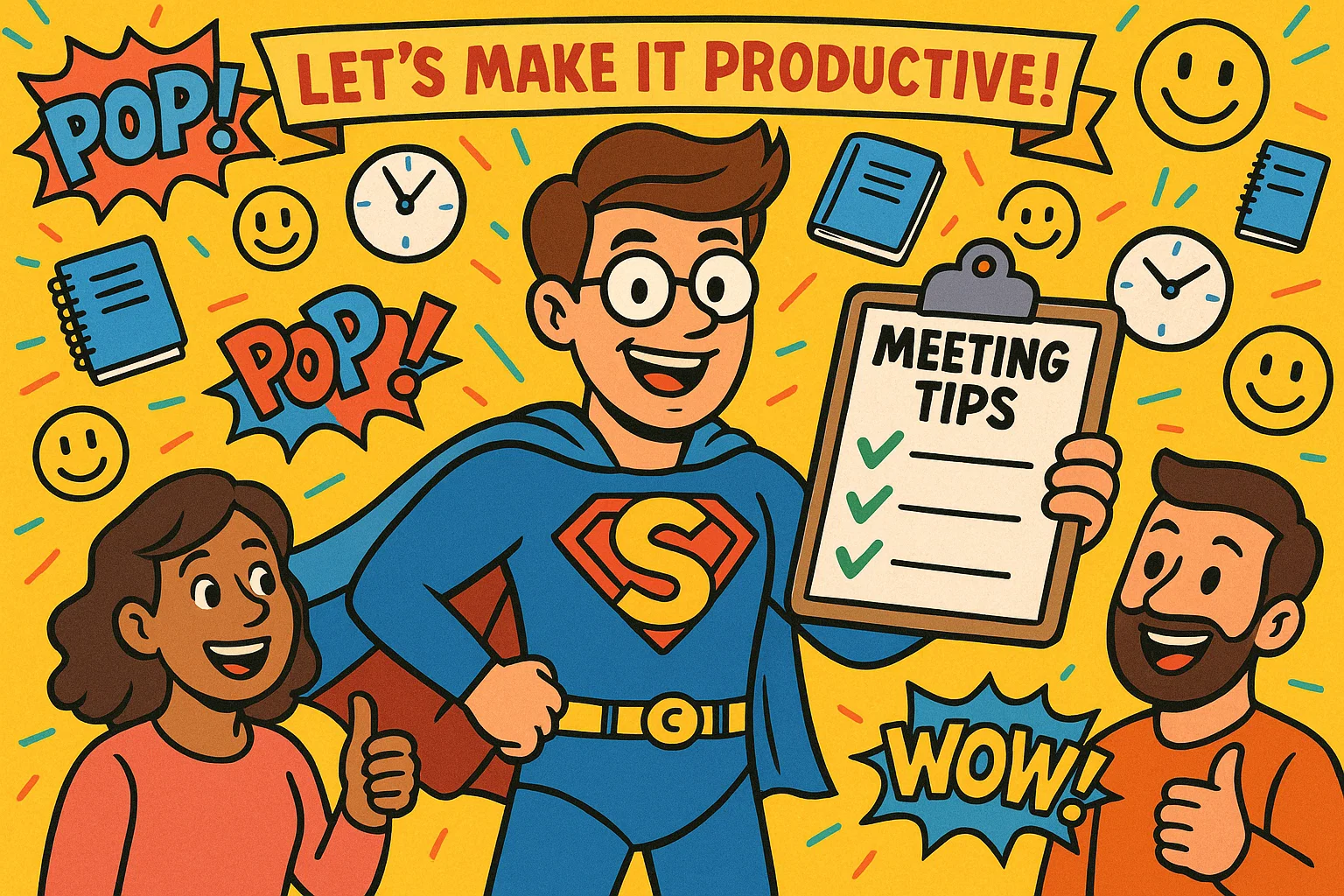Points to Discuss in Parent-Teacher Meeting

Parent-teacher meetings are among the most valuable 15–30 minutes in a child’s school year. More than just routine check-ins, they’re opportunities for parents and teachers to share insights, align goals, and plan how to best support a child’s academic and emotional growth. With a bit of preparation and clear questions, these meetings can turn from formal updates into truly productive, collaborative conversations.
This guide highlights the key points to discuss, expert strategies for effective communication, and practical ways to build a strong partnership between home and school — all focused on helping every child thrive.
Purpose of Parent-Teacher Meetings

The fundamental objective of a parent-teacher meeting is to create a seamless bridge between the learning environment at school and home. This dedicated time allows teachers and parents to openly exchange insights that are often invisible to the other. For instance, a teacher may observe a student’s quiet leadership in group projects, while a parent may share that the child is struggling with focus during homework time. These meetings are the primary mechanism for establishing trust, developing mutual understanding of the student’s needs, and collectively formulating solutions to support the child’s development and learning. In essence, they serve as strategic planning sessions for the child’s future success.
Benefits for Parents and Teachers
When parents and educators collaborate, the benefits ripple out to positively impact the child’s entire experience.
| Party | Primary Benefits Gained from Collaboration | Outcome for the Child |
| Parents | Gain a deeper understanding of the child’s academic progress, specific learning styles, behavior at school, and social dynamics. They learn which areas for improvement to focus on at home. | Feeling fully supported, seeing continuity between home and school, and having clear expectations. |
| Teachers | Gain insight into the child’s home life, motivations, cultural background, and any potential stressors that may be affecting the student’s performance. They better understand the child’s strengths. | Receiving differentiated instruction and support tailored to their unique circumstances and needs. |
By aligning on the child’s academic needs and overall well-being, both parties can move swiftly from identifying challenges to implementing joint solutions. This shared responsibility ensures the child’s education is holistic and responsive.
Role in Student Success
Regular, effective parent-teacher conferences are strong predictors of student success. Research consistently suggests that high parent involvement in a child’s education leads to higher grades, better attendance, improved behavioral issues, and increased motivation. When parents and teachers work together to support the student, they send a clear, unified message: “Your education is a priority, and we are a team working on your behalf.” This collaborative relationship directly fosters the child’s sense of security and encourages them to take ownership of their learning. It helps both parties track the child’s progress and make timely interventions if the student begins to struggle.
Preparing for the Meeting
The most productive teacher meeting is one where both parties come prepared. Preparation turns a general conversation into an efficient discussion with clear objectives and tangible outcomes. It starts long before the scheduled time by actively observing the student’s habits and performance.
What Parents Should Review Beforehand
Prior to the parent-teacher conference, parents may want to gather all available information on the child’s academic standing and daily activities.
- Academic Work: Review report cards, tests, quizzes, and specific assignments. Look for patterns: Is the child consistently underperforming in one subject? Are there specific types of questions or concerns you have about their understanding?
- Teacher Notes/Communication: Read through the daily folder, email correspondence, or notes in the planner. Are there recurring mentions of incomplete work or behavioral issues?
- Child’s Input: Talk to your child. Ask your child for their perception of their classroom experience. Ask, “What are you most proud of in class?” and “Is there anything that feels really hard or confusing right now?”
- Draft Questions: Compile a list of questions about the child’s learning and write them down. This ensures you cover all your concerns, especially given the short time frame.
How Teachers Can Prepare
A teacher’s preparation ensures they can provide specific, data-driven feedback, which adds clarity and credibility to the discussion.
- Performance Report: Prepare a snapshot of the student’s performance, including specific data (e.g., test scores, reading levels, completed assignments). Highlight the child’s strengths and clearly define areas that need improvement.
- Behavioral Observations: Document concrete examples of both positive and challenging behavior. Instead of saying, “Your child is disruptive,” a teacher should say, “On Tuesday and Friday, [Child’s Name] spoke out of turn three times during independent reading.”
- Proposed Goals: Outline one to two initial, achievable goals and suggested strategies for home support. This shifts the focus immediately to collaborative problem-solving.
Setting a Collaborative Tone
An effective parent-teacher discussion begins with a positive mindset. The first few minutes are crucial for setting the stage. Begin the meeting by expressing appreciation for the teacher’s work and clearly stating that you are there as a partner. Begin with a positive comment about your child’s relationship with the class or teacher. For example, “Thank you for taking the time. [Child’s Name] often talks about how much they enjoy the science experiments.” This helps to establish a sense of shared purpose and a strong parent-teacher relationship.
Key Points to Discuss During the Meeting

The goal of this central section is to ensure all facets of the child’s development and academic life are covered, moving beyond simple grades to a holistic assessment.
Academic Performance and Progress
This is often the primary focus. Discuss specific subjects and skills.
Key Discussion Points:
- Current standing in core subjects (Math, Reading, Science).
- Understanding of foundational concepts.
- Participation level in class discussions.
- The quality and consistency of completed classwork.
- Child’s academic progress toward grade-level standards.
Parents should ask for specific examples of work that demonstrates struggle or mastery.
Classroom Behavior and Social Interaction
Understanding a child’s conduct and social landscape at school is vital, as these factors significantly affect learning.
- Social Development: How does the child interact with peers? Are they a leader, a follower, or a solitary worker?
- Behavioral Issues: Are there any challenges with following rules, transitions, or managing impulses?
- Group Work: How well does the child collaborate in a group setting? Do they contribute equally, or tend to dominate or withdraw?
The teacher should be able to provide context, explaining the potential root cause of any observed behavioral issues.
Strengths and Areas for Improvement
A balanced perspective is essential. Always start with the positives to encourage the student and build parental confidence.
- Child’s Strengths: Identify specific academic talents (e.g., strong writer, quick calculation) or character traits (e.g., kindness, persistence, creativity).
- Areas for Development: Clearly define areas that need more support. These should be framed as specific, achievable goals, such as “improving handwriting clarity” or “practicing multiplication facts.”
Homework and Study Habits
Discussing the student’s approach to tasks outside of the classroom offers insights into their self-discipline and organizational skills.
- Organization: How well does the child manage their materials, keep track of assignments, and use the planner?
- Workload: Is the amount of homework manageable? Is the student taking an appropriate amount of time to complete it? Learning at home needs to be an extension, not a battle.
- Parent Support: What is the appropriate level of parental assistance for completing assignments?
Emotional and Psychological Well-Being
The student’s emotional state dictates their readiness to learn.
- Motivation: Does the child seem excited or engaged in school?
- Self-Esteem: Does the teacher observe signs of low confidence or anxiety?
- Coping Mechanisms: How does the child handle disappointment or frustration during challenging tasks? It’s important for parents to be open to discussing any changes they’ve observed at home and school.
Communication and Parent Involvement
Discussing the flow of information is key to maintaining a strong, collaborative relationship.
- Preferred Contact Method: Agree on the best support method for regular updates (email, app, or brief notes).
- Parent Involvement Opportunities: How can parents help their child and the classroom (e.g., volunteering, supporting projects, participating in school activities)?
Future Goals and Academic Planning
Look ahead to ensure continuous improvement in the child’s academic progress.
- Short-Term Goals: What is the specific, measurable goal for the next 6–8 weeks (e.g., raising the math grade from a C to a B-)?
- Long-Term Goals: Discuss preparing for the next grade level or specific skills needed for their child’s future success (e.g., developing critical thinking).
Questions Parents Can Ask Teachers
Effective parent-teacher meetings require parents to ask insightful, focused questions that lead to actionable advice. Writing your list of questions beforehand ensures you do not forget crucial points.
Questions About Academics
These questions help you identify specific learning gaps and ways to implement learning at home.
- What are my child’s academic strengths and weaknesses, specifically?
- “What are the most challenging concepts or questions to ask the class right now?”
- “How is my child performing compared to grade-level expectations in reading/math?”
- “Can you show me an example of the kind of work you expect at this level?”
- “What specific resources or activities (books, websites) can I use at home to help my child in X subject?”
Questions About Social Behavior
Understanding social dynamics is crucial for fostering a well-adjusted, confident child.
- “How does my child interact with classmates during unstructured time, like recess?”
- “Is my child having any difficulty with communication between teachers and parents?”
- “Does my child take responsibility for their actions and materials?”
- “What are your observations regarding their maturity and independence in the classroom?”
- “Are there any emerging behavioral issues or challenges in handling disagreements?”
Questions About Emotional Growth
A child’s emotional resilience is key to their ability to navigate educational challenges.
- “Do you notice any signs of anxiety or low motivation regarding schoolwork?”
- “How does my child respond to constructive criticism or a lower grade?”
- “What can we do to support their confidence and willingness to try new things?”
- “How do you encourage self-advocacy (when students ask for help appropriately) in the classroom?”
Common Challenges and How to Overcome Them

While parent-teacher meetings are crucial, they sometimes face hurdles. Anticipating these helps ensure a smooth conversation.
Time Limitations
A 15-minute slot goes quickly.
- Strategy: Prioritize the top three key points from your written list. Let the teacher lead the agenda, but ensure your core concerns are addressed. Keep your responses concise, avoiding anecdotal stories. Focus on the most important points to discuss.
Sensitive Topics
Discussions about low grades, disciplinary issues, or a suspected learning difference require tact.
- Strategy: Approach these topics with an open, non-confrontational mindset. Frame the discussion around problem-solving: “I see my child is struggling with math. What steps can teachers and parents take together to address this?” Avoid assigning blame; emphasize, “We are a team.”
Communication Barriers
Language, cultural differences, or emotional responses can impede open dialogue.
- Strategy: Request an interpreter in advance if needed. If cultural differences impact behavior or expectations, parents should share these with the teacher. Maintain active listening (nodding, clarifying points) to show you are engaged and receptive to the teacher’s expertise.
Follow-Up After the Meeting
The conversation should not end when the clock runs out. The follow-up is where the true partnership is cemented and progress begins.
Creating an Action Plan
The meeting’s purpose culminates in a joint agreement on next steps.
- Define Achievable Goals: Create one to three specific, measurable short-term and long-term goals for the student. For example: “By the next meeting (4 weeks), [Child’s Name] will read for 20 minutes independently each evening,” or “The teacher will use a visual timer to help with transitions.”
- Assign Responsibilities: Clearly define who (parent, teacher, or student) is responsible for each action. Document the key points and agreements.
Ongoing Communication
A strong parent-teacher relationship thrives on consistent, concise updates.
- Set Check-ins: Agree on a light, non-intrusive method and frequency for updates (e.g., a short email update once every two weeks). This is crucial for tracking the child’s progress.
- Open Communication: Remind the teacher that you are open to being contacted if a serious issue arises.
Tracking Improvements
Systematically monitor the impact of the action plan.
- Evidence Collection: Parents can track the impact of their efforts by reviewing homework and student portfolios. Teachers use observations and informal assessments.
- Follow-Up Meeting: If the goals are not met or new issues arise, schedule a follow-up meeting to adjust the plan.
Tips for Productive Parent-Teacher Meetings

Maximizing the value of the meeting requires following a few best practices for both parents and teachers.
Be Positive and Open-Minded
Enter the meeting ready to listen, not just to talk.
- Positive Framing: Frame challenges constructively. Instead of “He hates reading,” try “He needs help finding books that truly capture his interest.”
- Respect Expertise: Acknowledge the teacher’s experience. They work with dozens of children every day and often have a valuable perspective on classroom dynamics and learning.
Focus on the Child’s Needs
Every discussion point should focus on how the information can best support the individual student. Avoid comparisons with siblings or other students. The discussion must center on the child’s academic needs and overall well-being.
Document Key Takeaways
Take clear notes to ensure retention and accurate follow-through.
- Note-Taking: Record the teacher’s key observations, action plan, and agreed-upon goals. This document becomes your roadmap until the next meeting.
Example Parent-Teacher Meeting Agenda
Using a structured template helps ensure no crucial topic is overlooked and time is managed efficiently.
| Time Allotment | Discussion Topic | Objective/Key Points |
| 0–2 minutes | Introduction and Meeting Purpose | Establish rapport, thank the teacher, state the overarching goal (e.g., “Discuss [Child’s Name]’s learning and create joint goals”). Set a collaborative tone. |
| 2–7 minutes | Review of Academic and Behavioral Progress | The teacher shares specific data on academic performance, highlights a child’s strengths, and names areas that need improvement (e.g., “Math facts are strong; written structure is challenging”). |
| 7–12 minutes | Parent Concerns and Questions | Parents ask their prepared list of questions about the child’s learning, social development, and home support. Parents share relevant information about home life or habits. |
| 12–15 minutes | Goal Setting and Next Steps | Jointly agree on 1–3 specific, measurable short-term and long-term goals. Define the action plan for school and home. Agree on the follow-up communication method. |
Conclusion: Key Points to Discuss in Parent-Teacher Meeting and Takeaways
Parent-teacher conferences provide an excellent opportunity to strengthen the partnership essential for every child’s success. The goal is always to work with parents to create the most supportive and enriching environment possible. By focusing on a structured discussion that covers the whole child—their academic performance, behavior at school, emotional well-being, and social dynamics—you empower both the student and the educators. Effective parent-teacher meetings are not passive reviews; they are active, collaborative planning sessions that shape the child’s future.
Summary of Key Discussion Areas
To ensure a comprehensive dialogue, always cover these four pillars:
- Academics: Child’s academic progress, specific subject strengths, and areas for improvement.
- Behavior: Classroom conduct, interactions with peers, and social development.
- Well-being: Emotional state, motivation, and coping with challenges.
- Action Plan: Achievable goals and clear steps for learning at home and at school.
Encouragement for Future Collaboration
Remember that the relationship you build with your child’s teacher is one of the most valuable assets in their educational journey. Maintaining open communication and being prepared for every meeting with specific questions or concerns demonstrates a commitment to your child’s success. Embrace these opportunities to collaborate and ensure your child receives the best support possible, helping them thrive not just academically, but as a well-rounded, confident individual.
